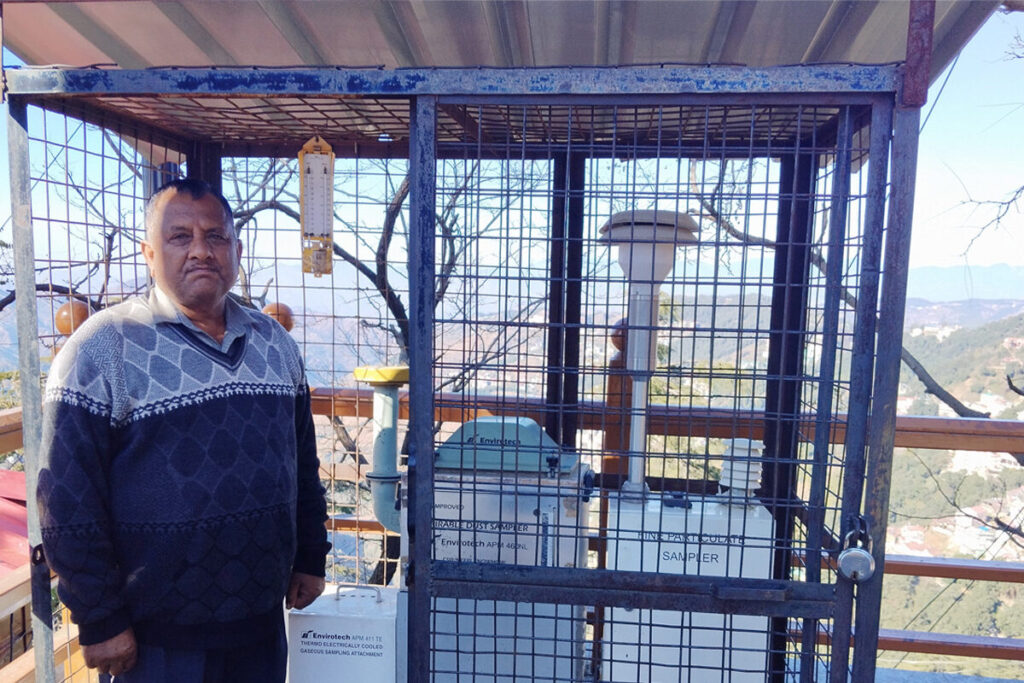India Gears Up To Use ‘eDNA’ To Identify, Track Wildlife
Dec 23, 2023 | Pratirodh Bureau
An Air Quality Monitoring Station in Shimla (Photo by Sanjeev Kumar)
- The Zoological Survey of India is testing new technology to assess biodiversity using environmental DNA (eDNA).
- eDNA technology can aid researchers in quantifying wildlife, flora and fauna and even explore elusive species.
- The new technology may also be able to provide much-needed data on invasive alien species in India.
The Zoological Survey of India (ZSI) has set up a pilot project to use eDNA (environmental DNA), to study and monitor wildlife.
At present, researchers collect scat (fecal) material from animals and take them for identification. This is done in the areas they are studying. The DNA of the particular targeted species is then sorted out for population estimation.
However, a study by scientists from the United Kingdom has stated that air-quality networks collect environmental DNA with the potential to measure biodiversity at continental scales and that these samples have ‘surprisingly stable DNA’, and it is the best possible method to ascertain terrestrial biodiversity.

ZSI’s pilot project, based on this study, will do this through air quality monitoring stations, set up by various government authorities, that are used to identify and collect particulate matter present in the air. These stations have two filters, PM10 and PM2.5, which collect air particles to quantify levels of pollution in the air. “These filters are changed in eight hours, in the case of PM10 and 24 hours for PM2.5 respectively,” said Rajender Kumar, a scientific officer with the Himachal Pradesh Pollution Control Board. Based on the particulate matter present or collected on filters, the levels of pollution in the air are determined after processing and analysing filters in the lab.”
The study also added that “air monitoring networks are in fact gathering eDNA data reflecting local biodiversity on a continental scale, as a result of their routine function. In some regions, air quality samples are stored for decades, presenting the potential for high-resolution biodiversity time series. With minimal modification of current protocols, this material provides the best opportunity to date for detailed monitoring of terrestrial biodiversity using an existing, replicated transnational design and it is already in operation.”
Lalit Kumar Sharma, a scientist with the Kolkata-based Zoological Survey of India, told Mongabay-India that they have started a pilot project in North Bengal to collect animals’ eDNA and monitor wildlife by using air filters or air quality monitoring stations. “For eDNA collection, we will make use of particulate materials collected on filters at the air quality monitoring station for ascertaining wild population and flora and fauna of the region,” he said. “The new methodology can even help the scientific community in finding elusive species that lived in a particular region, but haven’t been discovered by anyone to date.”
He added that the technology is currently being used in the United States and Europe to monitor biodiversity and assess the flora and fauna of a region.
eDNA For Biodiversity Monitoring
Ajay Bijoor, a programme coordinator with Nature Conservation Foundation (NCF) said the present methodology used to estimate wildlife, especially the International Union for Conservation of Nature (IUCN)-designated species, is a sort of trial and error method.
He explained that whenever a researcher or scientist goes for population estimation, one has to form small teams with local forest officials or volunteers to trap the targeted species or collect fecal matter. The next steps involve carefully preserving the samples and sending them to DNA labs for analysis.
“It costs around Rs. 1,000 to Rs. 1,500 per sample for processing at labs and takes around one or two weeks to complete the process,” ZSI’s Lalit Sharma added. He highlighted that ZSI has its own labs to process and analyse DNA but “for independent researchers or scientists at state departments, finding labs and processing the samples can be tough and time-consuming”.
 “The eDNA has tremendous potential to develop our understanding of biodiversity science and provide implications for conservation practices with census data of species present at a comprehensive scale in real-time,” noted a May 2022 study on using environmental DNA as a tool for biodiversity monitoring in aquatic systems.
“The eDNA has tremendous potential to develop our understanding of biodiversity science and provide implications for conservation practices with census data of species present at a comprehensive scale in real-time,” noted a May 2022 study on using environmental DNA as a tool for biodiversity monitoring in aquatic systems.
The authors, Manisha Ray and Govindhaswamy Umapathy note that environmental DNA (eDNA) was introduced in the field of microbiology for the detection of microbial communities in sediments in 1987. “DNA extracted non-invasively from environmental sources like soil, air, or water is termed environmental DNA (eDNA),” says the study. Aggregates of eDNA greater than 0.2 µm are termed as particulate DNA (P-DNA) while those lesser than 0.2 µm are termed as dissolved DNA (D-DNA).
The origin of eDNA can be several sources such as sloughed cells, fecal matter, spores, slimy coating (in amphibians), or dead carcasses.
The study says “the traditional practices of estimating biodiversity are biased towards the sampling of particular species or can also pose a risk to sensitive organisms”.
The eDNA technique has also been used in the aquatic system to either detect the presence or absence of a species or for quantitative estimation of a particular species. “Its application varies between lotic and lentic ecosystems as their nature varies,” the study added. “The lotic ecosystem is flowing and can transport eDNA directionally downstream from the correct location of the target organism, whereas the lentic ecosystem is stagnant. eDNA is released into the environment and subsequently undergoes progressive decay due to many biotic and abiotic factors.”
Umapathy told Mongabay-India that the particulate matter collected for eDNA established that it not only contains DNA of wildlife, flora, and fauna of a particular region, but also information on fungi and even various viruses.
“Our analyses have shown that eDNA tech can accurately predict and quantify biodiversity and wildlife in a particular area or region,” Umapathy added.
eDNA Can Prepare For Better Conservation
Umapathy’s study noted that there are many applications in which eDNA ranging can be used for conservation purposes. It can help in the “detection of invasive species, elusive species or any other ecologically important or threatened species to unravel community dynamics and their response to changing spatial-temporal changes.”
For instance, a few years ago, a study in the U.S. used the eDNA technique to study the “introduction and spread” of silver carp (Hypophthalmichthys molitrix), which is an invasive species. For a biodiversity-rich country such as India, which is battling conservation issues including a massive problem of invasive species threatening natural and agricultural landscapes, it can contribute significantly.
It is estimated that India has lost $127.3 billion (Rs 8.3 trillion) in the last 60 years due to 10 invasive alien species. The frightening part is that a lot of research is still required regarding the impact of invasive alien species, but that is hampered by lack of data.
The eDNA technology can help organisations, whether government or independent, in preparing “better conservation focus on regions or species of special importance. In this era of unprecedented climate change and concerns possessed by it, eDNA can help assist in the monitoring of biodiversity alongside other conventional methods to yield better results”, added the study.
(Published under Creative Commons from Mongabay-India. Read the original article here)
